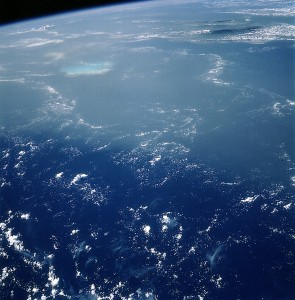Seem Hazy in Central Texas? It’s All Saharan Dust in the Wind

Taken by astronauts on International Space Station mission STS065 on July 11, 1994 / JSC Astromaterials Research & Exploration Science Directorate, NASA, The International Space Station
This image, taken by astronauts in the International Space Station from 160 above Earth, shows a Saharan dust cloud floating across the Caribbean. The camera is pointed southwest and the land in the upper right is Haiti.
Some Texans have been able to enjoy exceptional sunsets this week as billions of tiny grains of dust from afar traverses our skies. A dusty drifter from 6,500 miles away — a giant mass of super-fine sediment and dry air from the Sahara Desert — is visiting Central Texas this week.
Saharan dust blows across the Caribbean and passes through Texas most summers, says meteorologist Jason Dunion with the National Oceanic & Atmospheric Administration. The dust is blown out of Africa in giant windstorms.
“What makes these things so incredible is how big they are. They’re the size of the lower 48 states, so you’re basically stirring up this continent-sized land mass and blasting it out into the Atlantic,” says Dunion, who was the principle investigator in the Saharan Air Layer Group.
The heavier dust falls to earth early in the weeklong trans-Atlantic voyage, so the air mass above Texas carries only the finest dust, just a fraction of a human hair in diameter.
Giant dust storms hit the Sahara every three to five days in the summer, but the dusty wind has been blowing farther West more frequently than usual this year, Dunion says. Texas got another whiff of the Sahara earlier this summer.
“There is some hint that there’s an ebb and flow, periods where you more dust storms pouring into the Atlantic versus a little bit less. The effect on climate we can’t really answer because we’ve been looking at it for such a short time.”
The drifting dust clouds have been studied since the early 1970s, but there wasn’t a way to track them until about 10 years ago, according to Dunion.
The super-dry air will suppress rainstorms and the fine dust can agitate asthmatics, though it isn’t known to cause any lasting damage. The Saharan dust should leave Central Texas today, but there’s still a chance to see the exotic air before it goes.
“A great way to see the dust is the way it reflects the sun. At sunset and sunrise is a great time to see that the sky gets this kind of glow to it and you’re actually seeing Saharan dust that’s traveled, in your case, about 7,000 miles,” Dunion says.